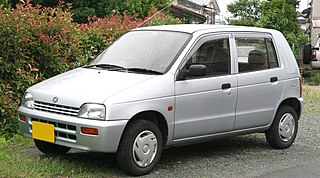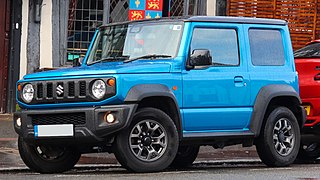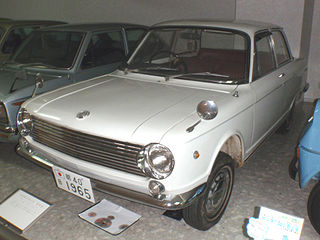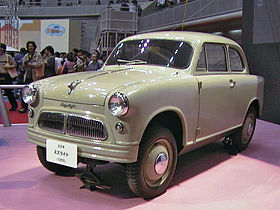
The Mazda Carol is a kei car manufactured by Mazda from 1962 until 1970. The Carol name was revived again with Mazda's 1989 re-entry into the kei car class with the Autozam brand. Since 1989, the Carol has been a rebadged model manufactured by Suzuki for Mazda, based on the Japanese Suzuki Alto. The first two generations of the modern era Carols received unique bodywork, but since late 1998 the nameplate has been strictly a badging exercise.

The Subaru Rex is a kei class automobile manufactured and marketed for model years 1972-1992 by Subaru primarily for the Japanese Domestic Market, although it was also sold in Europe, South America, Australia and the Caribbean — variously as the Ace, Viki, Sherpa, 500/600/700, Mini Jumbo, Mini Subaru or M60/M70/M80.

The Suzuki Alto is a kei car produced by Suzuki since 1979. The model, currently in its ninth generation, was first introduced in 1979 and has been built in many countries worldwide. The Alto originated as a commercial vehicle derivative of the Fronte, but over time the Alto nameplate gained in popularity and by 1988 it replaced the Fronte name completely. The Alto badge has often been used on different cars in Japan and in export markets, where it is considered a city car.

The Daihatsu Fellow Max is a small Japanese automobile in the Kei car class. Originally introduced as the Daihatsu Fellow, the name was partially retained for its successor, the Max Cuore (1977), and then revived in 2000 for the Daihatsu Max.

The Mitsubishi Minica is a model series of kei cars, produced by Mitsubishi Motors Corp. (MMC) over five generations, from 1962 to 2011, mainly for the Japanese domestic market.

The Suzuki Jimny is a series of four-wheel drive off-road mini SUVs, manufactured and marketed by Japanese automaker Suzuki since 1970.

The Suzuki Fronte is an automobile introduced in March 1962 as a sedan version of the Suzulight Van. The nameplate remained in use for Suzuki's Kei car sedans as well as some commercial-use derivatives until it was replaced by the Alto in September 1988.

The Daihatsu Hijet is a cab over microvan and kei truck produced and sold by the Japanese automaker Daihatsu since 1960. Despite the similarities between the Hijet name and Toyota's naming scheme for its trucks and vans, the name "Hijet" has been in use for Daihatsu's kei trucks and microvans since 1960, over two decades before Toyota took control. "Hijet", when transliterated into Japanese, is very similar to "Midget", one of Daihatsu's other mini-trucks. According to Daihatsu, the name "Hijet" was created to imply that the vehicle offers higher performance than the Midget. The Hijet competes in Japan with the Honda Acty, Mitsubishi Minicab, Nissan Clipper, Subaru Sambar and Suzuki Carry.

The Honda Life is an automobile nameplate that was used on various kei car/city cars produced by Honda: passenger cars, microvans, and kei trucks. The first series of the nameplate was built between 1971 and 1974, with the nameplate revived in 1997 and used until 2014. The Japanese-market Life has rarely been marketed outside Japan.

The Suzuki Mighty Boy is an automobile produced by Japanese automaker Suzuki from 1983 to 1988. It was the only three-box pickup truck ever sold in the 550 cc era of the kei car class; most other kei trucks use a cab-over design. It was classified as a commercial vehicle in Japan and Australia so as to benefit from lower taxes for such vehicles, but its utility was restricted by its unconventional design.

The Subaru Sambar is a cabover truck and microvan manufactured and marketed by Subaru as Japan's second truck compliant with the country's strict Keitora (軽トラ) or Kei vehicle tax class, after the Kurogane Baby. Introduced in 1961 in microvan and Kei pickup configurations, the Sambar remains in production, now in its eighth generation — beginning with the sixth generation as a rebadged Daihatsu Hijet.

The Isuzu Elf is a medium duty truck produced by Isuzu since 1959. Outside Japan it is known as N series and Q Series. The range was originally mainly available in Japan and other Asian countries. Australia was another important market for the Elf and N series – to the extent that it was manufactured there from the 1970s using many local components. Since the early 1980s, it has also been sold and built in the United States, and also as the Isuzu N-Series. Only North America receives the wide-cab version.

The Mitsubishi Minicab is a kei truck and microvan, built and sold in Japan by Japanese automaker Mitsubishi Motors since 1966. In Japan, it was sold at a specific retail chain called Galant Shop. It was also sold by China Motor Corporation (CMC) in Taiwan as the CMC Veryca, starting in 1985. A battery electric model of the Minicab, called the Minicab MiEV, is sold in the Japanese market since December 2011.
The Suzuki Cervo is a kei car manufactured by Suzuki Motor Corporation. Introduced in 1976 as the successor to the Suzuki Fronte Coupé, the Cervo name was originally affixed to a kei sports coupe, and then to models derived from the Suzuki Alto. The nameplate was retired between 1998 and 2006, and again in December 2009.

The Suzuki Carry is a kei truck produced by the Japanese automaker Suzuki. The microvan version was originally called the Carry van until 1982 when the passenger van versions were renamed as the Suzuki Every. In Japan, the Carry and Every are kei cars but the Suzuki Every Plus, the bigger version of Every, had a longer bonnet for safety purposes and a larger engine; export market versions and derivatives have been fitted with engines of up to 1.6 liters displacement. They have been sold under myriad different names in several countries, and is the only car to have been offered with Chevrolet as well as Ford badges.

Hope Motor Company was a Japanese car company bought by Suzuki in 1968. In December 1967, they released the HopeStar ON360, with a Mitsubishi 360-cc two-stroke, straight-two ME24 engine producing 21 bhp. The ON360 had a four-wheel drive layout. While 100 engines were purchased from Mitsubishi, most sources state that only 15 ONs were finished, all in 1968. Their earlier model, the HopeStar SM, was affectionately referred to in Japanese as the sanrin (三輪)" or "three wheels".

The Suzuki Fronte 800 is a subcompact car with a two-stroke engine built by the Suzuki Motor Corporation in the latter half of the 1960s.

LC10 was the original name given to a series of very small three-cylinder, two-stroke engines built by Suzuki Motor Corporation in the 1960s and 1970s. They were used in a number of kei class automobiles and light trucks. The LC10 and its derivatives did not completely replace the FE and L50 two-cylinders, which continued to be used mainly for light commercials. The LC10 engine was developed together with the Suzuki B100 engine, a 8–11 PS (5.9–8.1 kW) 118.9 cc (7.26 cu in) single-cylinder motorcycle engine which shared the same bore and stroke. For longevity and convenience, the LC10 received Suzuki's new "Posi-Force" auto-lubrication system, eliminating the need for pre-mixed fuel.

The Toyopet Master, introduced in January 1955, is a passenger car that was an evolution of the earlier Toyota SF/RH sedan with a modernized body. As with its predecessor, the Master has a ladder frame truck chassis with leaf sprung solid axles both at the front and the rear. The more conservative Master was sold in parallel with the first Toyota Crown as a frugally equipped and robust version meant for taxi usage. The Master and Crown shared the same R-series engine, which produces 48 PS (35 kW) in the Master. It was sold at a chain of Toyota Japan dealerships called Toyota Store, next to the more upscale Crown, which was intended as a private purchase alternative to the Master.

The Suzuki FB engine is a series of two- and three-cylinder two-stroke engines that was produced by the Suzuki Motor Corporation from October 1961 until November 1987. They were used in a number of Kei-class automobiles and light trucks. From the original air-cooled 359 cc (21.9 cu in) straight-twin version the FB series developed through a number of different models having different names, ending with the water-cooled, three-cylinder LJ50. The names used for various versions of this engine often refer to the chassis code of the cars in which they were introduced, until Suzuki changed their engine naming system sometime in the first half of the 1970s.























